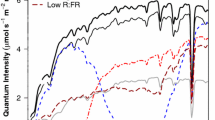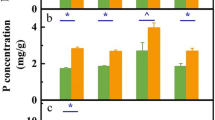Abstract
To investigate how seed reserves affect early seedling performance, we conducted a factorial greenhouse experiment using Lithocarpus densiflora (Tanoak). Seedlings were grown from large (5.8±0.7 g) and small (3.2±0.4 g) seeds and, following shoot emergence, seeds were either removed or left attached. Seedlings were harvested for quantification of biomass and δ13C at seven time periods following seed removal (2, 4, 8, 16, 32, 64, 128 days) and seedling photosynthesis was measured three separate time periods (2–4, 49–82, 95–128 days after seed removal). Biomass increased for all seedlings, but the increase was significantly larger for seedlings with attached seeds than with removed seeds. Seed removal just after shoot emergence significantly decreased seedling biomass, but seed removal 64 days after shoot emergence had no effect on seedling biomass. Seedling photosynthesis per unit leaf area varied by time and seed presence, but not by seed size. At the first period, seedlings with attached seeds had significantly higher photosynthetic rates than seedlings with removed seeds, at the second period there was no effect of seed removal, and at the third time period seedlings with attached seeds had significantly lower photosynthetic rates than seedlings with removed seeds. Despite temporal variation in photosynthesis per unit leaf area, seedlings with attached seeds always had significantly greater leaf area than seedlings with removed seeds, resulting in significantly higher total plant photosynthesis at all three time periods. The δ13C values of both the leaves and roots were more similar to that of the seed for seedlings with attached seeds than for seedlings with removed seeds, however, seed removal and seed size strongly affected root δ13C. This study demonstrates that seed reserves have important effects on the early growth, physiology, and δ13C of L. densiflora seedlings.




Similar content being viewed by others
References
Aizen MA, Woodcock H (1996) Effects of seed size on seedling survival and growth in Quercus rubra following simulated spring freeze. Can J Bot 74:308–314
Andersson C, Frost I (1996) Growth of Quercus robur seedlings after experimental grazing and cotyledon removal. Acta Bot Neerland 45:85–94
Armstrong DP, Westoby M (1993) Seedlings from large seeds tolerate defoliation better: a test using phylogenetically independent contrasts. Ecology 78:1092–1116
Black JN (1958) Competition between plants of different initial seed sizes in swards of subterranean clover (Trifolium subterraneum L.) with particular reference to leaf area and light microclimate. Australian J Agric Res 9:299–318
Bonsil C (1998) The effects of seed size, cotyledon reserves, and herbivory on seedling survival and growth in Quercus rugosa and Quercus laurina (Fagaceae). Am J Bot 85:79–87
Bossema I (1979) Jays and oaks: an eco-ethological study of a symbiosis. Behaviour 70:1–117
Boutton TW, Yamasaki S (1996) Mass spectrometry of soils. Marcel Dekker, New York
Brookes PC, Wigston DL, Bourne WF (1980) The dependence of Quercus robur and Quercus petraea seedlings on cotyledon potassium, magnesium, calcium, and phosphorus during the first year of growth. Forestry 53:167–177
Burke MJW, Grime JP (1996) An experimental study of plant community invasibility. Ecology 77:776–790
Burris JS, Edje OT, Wahab AH (1973) Effects of seed size on seedling performance in soybeans. II. seedling growth and photosynthesis and field performance. Crop Sci 13:207–210
Chenevard D, Frossard JS, Lacointe A (1994) Lipid utilization and carbohydrate partitioning during germination of English walnut (Juglans regia). Ann Sci For 51:373–379
Dalling JW, Harms KE (1999) Damage tolerance and cotyledonary resource use in the tropical tree Gustavia superba. Oikos 85:257–264
Dalling JW, Harms KE, Aizprua R (1997) Seed damage tolerance and seedling resprouting ability of Prioria copaifera in Panama. J Trop Ecol 13:481–490
Dawson TE, Mambelli S, Plamboeck AH, Templer PH, Tu KP (2002) Stable isotopes in plant ecology. Annu Rev Ecol Syst 33:507–560
Farquhar GD, Ehleringer JR, Hubick KT (1989) Carbon isotope discrimination and photosynthesis. Annu Rev Plant Physiol Plant Mol Biol 40:503–537
Ghashghaie J, Duranceau M, Badeck FW, Cornic G, Adeline MT, Deleens E (2001) δ13C of CO2 respired in the dark in relation to δ13C of leaf metabolites: comparison between Nicotiana sylvestris and Helianthus annuus under drought. Plant Cell Environ 24:505–515
Grime JP, Jeffery DW (1965) Seedling establishment in vertical gradients of sunlight. J Ecol 53:621–642
Harper JL (1977) Population biology of plants. Academic, London
Howe HF, Richter WM (1982) Effects of seed size on seedling size in Virola surinamensis; a within and between tree analysis. Oecologia 53:347–351
Howe HF, Smallwood J (1982) Ecology of seed dispersal. Annu Rev Ecol Syst 13:201–228
Jarvis PG (1963) The effects of seed size and provenance on the growth of seedlings of sessile oak. Q J For 57:11–19
Kitajima K, Fenner M (2000) Ecology of seedling regeneration. In: Fenner M (ed) Seeds: the ecology of regeneration in plant communities. CABI, New York, pp 331–360
Kormanik PP, Sung SS, Kormanik TL, Schlarbaum SE, Zarnoch SJ (1998) Effect of seed size on development of northern red oak 1–0 seedlings. Can J For Res 28:1805–1813
Lloret F, Casanovas C, Penuelas J (1999) Seedling survival of Mediterranean shrubland species in relation to root:shoot ratio, seed size and water and nitrogen use efficiency. Funct Ecol 13:210–216
Mack AL (1998) An advantage of large seed size: tolerating rather than succumbing to seed predators. Biotropica 30:604–608
Merouani H, Branco C, Almeida MH, Pereira JS (2001) Effects of seed storage duration and parental tree on emergence and physiological status of Cork oak (Quercus suber L.) seedlings. Ann For Sci 58:543–554
Nyandia CO, McPherson GR (1992) Germination of two warm temperate oaks, Quercus emoryi and Quercus arizonica. Can J For Res 2:1395–1401
Rosenthal JP, Kotanen PM (1994) Terrestrial plant tolerance to herbivory. Trends Ecol Evol 9:145–148
Smedley MP, Dawson TE, Comstock JP, Donovan LA, Sherrill DE, Cook CS, Ehleringer JR (1991) Seasonal carbon isotope discrimination in a grassland community. Oecologia 85:314–320
Sonesson LK (1994) Growth and survival after cotyledon removal in Quercus robur seedlings grown in different natural soil types. Oikos 69:65–70
Sousa WP, Kennedy PG, Mitchell B (2003) Propagule size and predispersal damage by insects affect establishment and early growth of mangrove seedlings. Oecologia 135:564–575
Stanton ML (1984) Seed variation in wild radish: effect of seed size on components of seedling and adult fitness. Ecology 65:1105–1112
Underwood AJ (1997) Experiments in ecology: their logical design and interpretation using analysis of variance. Cambridge University Press, Cambridge
USDA (2003) National Nutrient Database for Standard Reference. http://www.nal.usda.gov/fnic/foodcomp/index.html. Cited 12 Dec 2003
Vaughton G, Ramsey M (1998) Sources and consequences of seed mass variation in Banksia marginata (Proteaceae). J Ecol 86:563–573
Weiner J (1990) Asymmetric competition in plant populations. Trends Ecol Evol 5:360–364
Wulff RD (1986) Seed size variation in Desmodium paniculatum. II. Effects on seedling growth and physiological performance. J Ecol 74:99–114
Acknowledgements
The authors would like to thank the Marin Municipal Water District for use of their land; J. Diaz, J. Hu, K. Peer, V. Schmidt for field and greenhouse assistance; N. Teutsch and V. Schmidt for assistance in preparation of isotope samples; and S. Mambelli for assistance in analyzing the isotope samples at the Center for Stable Isotope Biogeochemistry (CSIB), UC Berkeley. The work was supported by a NSF Graduate Research Fellowship and a CSIB graduate research reward to P.G.K.
Author information
Authors and Affiliations
Corresponding author
Rights and permissions
About this article
Cite this article
Kennedy, P.G., Hausmann, N.J., Wenk, E.H. et al. The importance of seed reserves for seedling performance: an integrated approach using morphological, physiological, and stable isotope techniques. Oecologia 141, 547–554 (2004). https://doi.org/10.1007/s00442-004-1686-0
Received:
Accepted:
Published:
Issue Date:
DOI: https://doi.org/10.1007/s00442-004-1686-0




